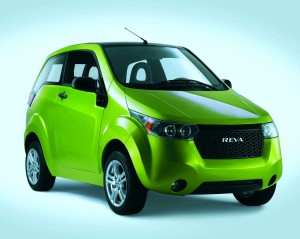
GM is moving forward on a range of pure battery-powered vehicles, well beyond the little NXR it will sell in India as part of a joint venture.
While General Motors plans emphasize hybrids, plug-ins and so-called extended-range electrics, like the Chevrolet Volt, the automaker is quietly at work developing some pure battery-electric models that could hit the road in the next few years, officials have confirmed to TheDetroitBureau.com.
Senior GM officials are still skeptical about the potential for vehicles relying on batteries along, but they also see the need for what product development czar Tom Stephens describes as a “robust product portfolio” that can address the broadest possible mix of energy alternatives and consumer needs.
The key takeaway, GM officials stress, is that electric power, in one form or another, is rapidly becoming an essentially element in the company’s model mix.
“We have to come up with a robust product portfolio that can take advantage of all (the various) energy alternatives and do it efficiently,” said Stephens.
Until recently, GM officials prefered to direct the media spotlight towards an array of products pairing battery power and the internal combustion engine, such as mild hybrids like the one first introduced on the Saturn Vue, advanced two-mode hybrid-electric systems, such as the one used in the Cadillac Escalade, and extended-range electric vehicles, or E-REVs, such as the Chevrolet Volt.
The latter model is designed to run exclusively on electric power for up to 40 miles, then switch to a small inline-four-cylinder gasoline engine, which works as an onboard electric generator. That approach, stressed Stephens, avoids so-called “range anxiety.” With rare exception, the pure battery-electric vehicles, or BEVs, offered by competitors such as Nissan, with its Leaf, get only about 100 miles on a charge.
But GM has concluded that this might be enough under certain conditions, said Micky Bly, who oversees the Volt and other electric vehicle programs. “We’re absolutely looking into it,” he explained, in an exclusive interview with TheDetroitBureau.com.
The consensus among GM officials is that BEVs will have much more limited application than the various forms of hybrids, up to and including Volt. They seem better suited to markets where motorists drive relatively short distances, where places to plug in could be made available both at home and on the road, and where weather conditions are reasonably mild. Heating and cooling systems require a lot of range-sapping energy, and the latest lithium-ion batteries are most efficient in the same climates that humans naturally prefer, around 70 degrees Fahrenheit.
One opportunity would be in smaller European cities, said Bly. Others would include places like Singapore, where drivers clock relatively few miles, or even San Diego, where temperatures remain balmy much of the year, added Stephens.
Ironically, while “battery cars are the easiest thing to do” from a technical standpoint, said Stephens, they are far more difficult to develop in a form that can satisfy consumer needs. By weight, a battery stores only about 1% of the energy found in gasoline. They are bulky and costly, and best suited to use in small products – like Nissan’s Leaf – rather than the big cars and trucks American motorists have traditionally preferred.
Nonetheless, said Bly, “We would be wise not to ignore (BEVs).” If nothing else, GM is well aware that most of its key competitors, including not only Nissan but Toyota, Ford and Daimler, will be entering that new market segment over the next few years.
GM has confirmed only one battery car program, so far, a joint venture in India.
How soon other products might reach market is unclear. “We still have a lot to do,” said Stephens, before GM feels it has a pure battery car design it can take to market, though company sources suggest that simply means such products won’t reach market until around the middle of the new decade.

Gee, you mean E85 flex fuels are not a part of the solution? Go figure ……
Actually, the way the EPA figures Volt under proposed rules is 230 mpg…
KZ- editor
Leave it to the EPA to come up with a figure that no one buys. (And, to Nissan’s credit, they pointedly have declined to promote the tentative 300 mpg rating for their Leaf battery car, while GM plastered billboards up, all over the country, pitching the Chevy Volt’s 230 mpg numbers.) In reality, Volt is expected to get about 400 miles total, using a fully-charged battery and a single tank of fuel. Subtract the 40 miles on electric propulsion and you’re looking at a rating of roughly 45 mpg. That’s great for the segment, compared with traditional cars, but even when the LIon batteries run down, Volt will continue functioning as a hybrid, much like, say the Fusion or Camry hybrids or the dedicated Prius hybrid. So, it’s got better mileage, on gasoline, than most hybrids, but less than Prius.
Did I further confuse things?
Paul A. Eisenstein
Publisher, TheDetroitBureau.com